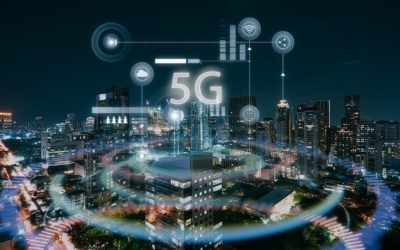If 5G Means Dimensionality for the IoT, Will 6G Bring Us a 6th Sense?
08
July 2021
Pente Networks Marketing
6G (sixth-generation wireless) is the successor to 5G cellular technology, but how different will the world of IoT be when higher frequency networking becomes a reality?
Experts say 6G will provide substantially higher capacity and much lower latency, supporting one micro-second latency communications, representing 1,000 times than one-millisecond throughput, which sounds brilliant – so then why is the GSMA worried?
“5G has the potential to boost the world’s GDP [gross domestic product] by $2.2 trillion,” said John Giusti, the GSMA’s chief regulatory officer, in a statement. “But there is a clear threat to this growth if sufficient 6GHz spectrum is not made available for 5G. Clarity and certainty are essential to fostering the massive, long-term investments in this critical infrastructure.”
According to the world’s largest mobile industry trade group, spectrum regulators are being asked to set aside 1-2GHz of total spectrum for 5G to meet users’ demands through 2030, with some of that spectrum available on the 6GHz band.
“The 6GHz range is a mid-band frequency and sits at a balancing point between coverage and capacity, providing the perfect environment for 5G connectivity,” the GSMA said, and while U.S. regulators and many countries in Latin America have set aside all the full 6GHz band for unlicensed activities, China is allocating the full 6GHz band toward licensed 5G operations, and the EU is somewhere in the middle.
American regulators at the FCC voted last year to allocate the entire 6GHz band for unlicensed operations.
Interestingly, tech giants in the U.S., including Facebook, Apple, Google, and Qualcomm, are continuing to meet with the FCC to lobby for three specific applications supported by 6G: client-to-client communications automating device-to-device communications, Very Low Power operations without the need for Automatic Frequency Coordination technology, and Mobile operations (which would permit mobile connections using Automatic Frequency Coordination).
We asked Roy Timor-Rousso, Chief Revenue Officer at JpU, an enterprise 5G provider with a platform designed to enable organizations to build and operate their own private 5G network, how the evolution to 6G will impact innovation in the business applications 5G is already improving, including IoT, Industrial IoT, factory automation, smart buildings, smart cities, smart agriculture, asset tracking and more.
“The answer is quite simple,” Timor-Rousso said. “We’ll start to see more advanced products and services that leverage AI, with a computational wireless infrastructure that supports high volumes of real-time supercomputing, and super smart edge, mesh, and cloud combinations supported by 6G’s ability to autonomously determine the best location for computing to occur, with business intelligence baked into everything from data storage and processing to resource sharing including federated and neutral host sharing.”
6G is expected to support data rates of 1 terabyte per second (Tbps), making the “science fiction” in the “sixth dimension” no longer a fantasy. Early trials are proving unprecedented speed, ubiquitous wireless connectivity, high-compute cognition, real-time sensing, and high-resolution real-time imaging.
“Today, we are making tremendous progress on multi-edge and mobile-edge computing (MEC), but in the future, MEC will be built into all 6G networks,” Timor-Rousso said. “Edge and core computing merge blur the lines between communications and computation. In many ways, we have only recently begun to commercialize 5G, but the impact has been massively disruptive, for example removing the barriers enterprises have faced since the beginning of data networking and allowing them to build their own 5G networks and even sell capacity and services as neutral hosts. This kind of business model innovation is what will drive trillions of dollars of value and threaten traditional mobile operators, opening the door for tech companies to build their own network fabrics and bypass, once again, those telecom companies who find it hard to change.”
6G is expected to launch commercially in 2030 and is being developed in response to the increasingly distributed radio access network (RAN), to Open RAN (O-RAN) acceleration, and the desire to take advantage of terahertz spectrum to increase capacity, lower latency, and dramatically reduce costs.
“We’ve learned over the last thirty or so years that successful communications companies who have set their sights on becoming digital service providers must change with the times,” Timor-Rousso said. “The good news about 6G is that we are already working out challenges associated with 5G. And the even better news about 6G is the impact it will have on society, including more effective public safety and security solutions, detection of cyberattacks, environmental and toxicity sensing, health monitoring, precision growing that addresses food insecurity, and mass-scale of autonomous vehicles on the roads and in the cities of the future.”
Timor-Rousso said the primary drivers for 6G are mainly associated with edge computing, automated systems, and the Industrial IoT. “Given the billions of dollars being invested in high-performance computing, while some may say centralized hyper clouds may no longer be necessary, those of us who understand the benefits of centralized management across thousands or tens of thousands of local edge sites envision a world where mobile backhaul will be used to take advantage of supercomputing centralized HPC resources,” Timor-Rousso explained.
“We’ve been so busy working in the fifth dimension, rolling out private enterprise 5G networks that we’re naturally quite focused on that, as are our partners and customers,” Timor-Rousso said. “If predictions come true, that speeds in excess of 100Gbps could make possible sensory interfaces that feel and look just like real life, then 6G, in fact, has the potential to create sixth sense solutions, on Earth and further out into space.”
For now, 5G is giving the ecosystem enough to say grace over. “One thing nobody will argue about is that 5G has validated the demand for fast and free spectrum connectivity is increasing at an exponential rate as wireless networking is becoming more and more essential to enterprises and people. It is tremendously exciting to think about 2030 as part of the continued evolution of generational wireless technologies and to learn as we go so when the 6G revolution comes, we will be ready.”
Originally published on 5G Evolution World
Similar Blogs
Pente Networks Introduces Pente Survivable Edge™ Solution for IoT and Industrial IoT Developers
Pente Networks™, developer of IT-First private enterprise LTE/5G solutions for system integrators, service providers and enterprises, today introduced the general availability of a plug-and-play, highly resilient and edge-to-cloud solution optimized on the Pente enterprise platform.
Pente Networks Names Technology Leader and Disrupter Avi Cohen CEO
Avi Cohen, a entrepreneur and innovator in the tech and networking industry, was named as the new Chief Executive Officer of Pente Networks, one of the pioneers in enterprise CBRS, 5G and LTE private networking.
Pente Networks Announces $10 Million Series A, Names Avi Cohen CEO
Even in a year that has seen a dramatic drop in venture funding, Pente Networks, developer of IT-centric enterprise LTE/5G solutions for service providers and their end customers, announced it has completed a $10 million Series A funding round.


